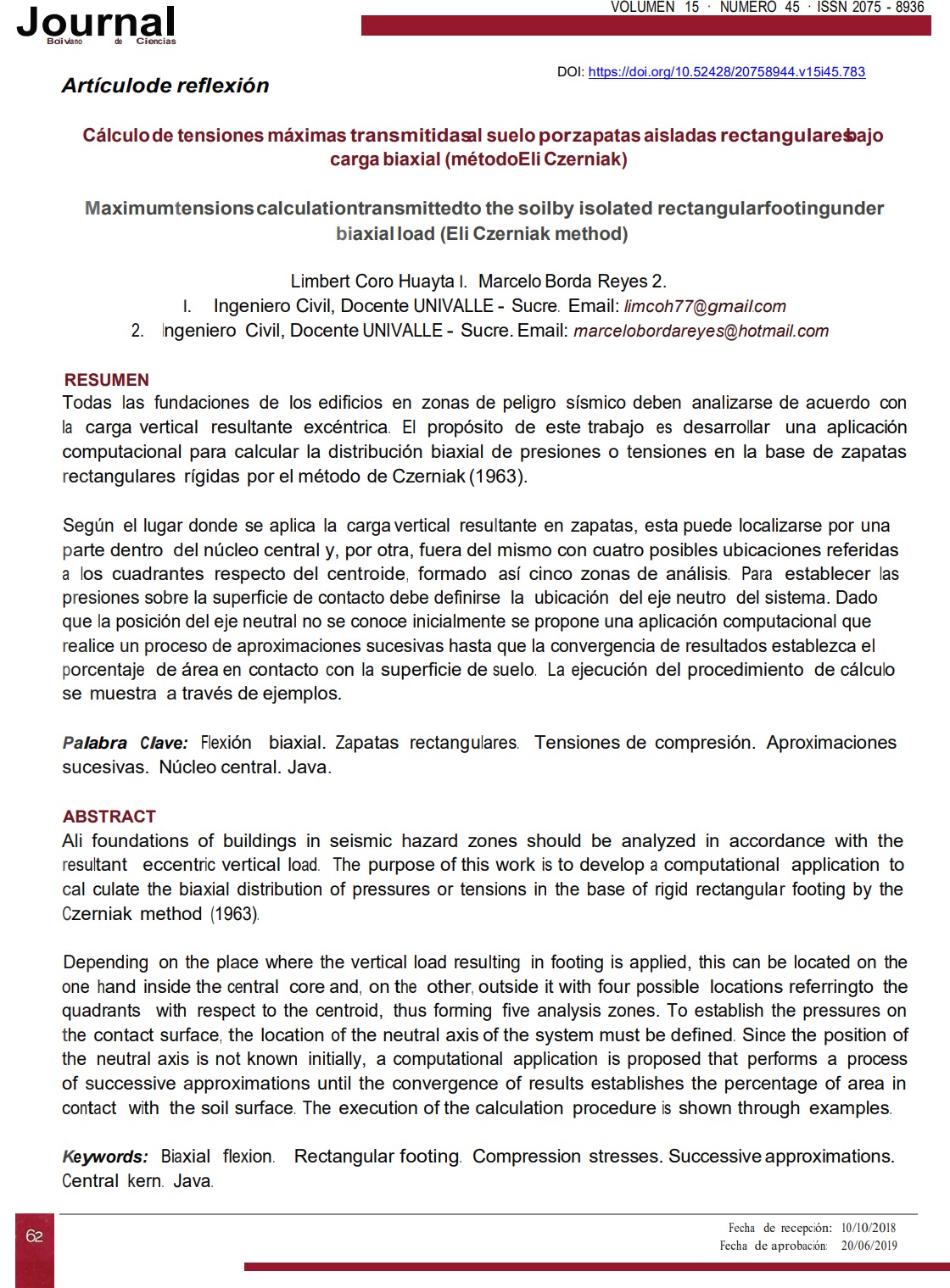Maximum Tensions Calculation Transmitted to the Soil by Isolated Rectangular Footing Under Biaxial Load (Eli Czerniak Method)
DOI:
https://doi.org/10.52428/20758944.v15i45.783Keywords:
Biaxial Flexion, Rectangular Footing, Compression Stresses, Successive Approximations, Central Kern, JavaAbstract
Ali foundations of buildings in seismic hazard zones should be analyzed in accordance with the resultant eccentric vertical load. The purpose of this work is to develop a computational application to calculate the biaxial distribution of pressures or tensions in the base of rigid rectangular footing by the Czerniak method (1963). Depending on the place where the vertical load resulting in footing is applied, this can be located on the one hand inside the central core and, on the other, outside it with four possible locations referringto the quadrants with respect to the centro id, thus forming five analysis zones. To establish the pressures on the contact surface, the location of the neutral axis of the system must be defined. Sin ce the position of the neutral axis is not known initially, a computational application is proposed that performs a process of successive approximations until the convergence of results establishes the percentage of area in contact with the soil surface. The execution of the calculation procedure is shown through examples.
Downloads
References
Czerniak, E. (1963). "How to calculate Footing Soil Bearing by Computer". Texas: Gulf Publishing Com-pany, 43: 109-114.
lbrahim, A. {2016). "New lterative method to Calculate Base Stress of Footings under Biaxial Bending" lnternational Journal of Engineering & Applied Sciences 8(4): 40-48. https://doi.org/10.24107/ijeas.281460
Instituto Nacional de Normalización. INN-CHILE. (1996): "Norma chilena oficial NCh433 Of. 1996: Diseño Sísmico de Edificios". Santiago: INN, Chile.
Jignesh, Ch. {2010). "Analysis Of Eccentrically t.oaded Rectangular Footing Resting On Soil - A Numerical Approach". Vadodara: L& T Sargent & Lundy Limited, India.
Ministerio de Obras Públicas, Servicios y Vivienda (2018) "Guía Boliviana de Diseño Sísmico", versión 3 (junio 2018), La paz: MOPSV-Bolivia.
Sarkar, B. (2014). "Analysis of isolated footing subjected to axial load and high biaxial moments and numerical approach for its solution", The lndian Concrete Journal, The lndian Concrete Journal, 6:60-80.
Nacional de Normalización. INN-CHILE. (1996): "Norma chilena oficial NCh433 Of. 1996:
Wilson, K. E. (1997). "Bearing Pressures for Rectangular Footings with Biaxial Uplift", Journal of Bridge Engineering, 2:27-33. https://doi.org/10.1061/(ASCE)1084-0702(1997)2:1(27)

Downloads
Published
How to Cite
Issue
Section
License
Copyright (c) 2019 Limbert Coro Huayta y Marcelo Borda Reyes

This work is licensed under a Creative Commons Attribution 4.0 International License.
Authors who publish with this journal agree to the following terms:
- Authors retain copyright and grant the journal right of first publication with the work simultaneously licensed under a Creative Commons Attribution License 4.0 that allows others to share the work with an acknowledgement of the work's authorship and initial publication in this journal.
- Authors are able to enter into separate, additional contractual arrangements for the non-exclusive distribution of the journal's published version of the work (e.g., post it to an institutional repository or publish it in a book), with an acknowledgement of its initial publication in this journal.
- Authors are permitted and encouraged to post their work online (e.g., in institutional repositories or on their website) prior to and during the submission process, as it can lead to productive exchanges, as well as earlier and greater citation of published work.














